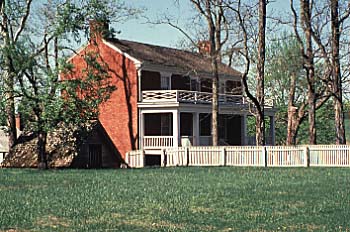09 April 2010
McLean House

(McLean House, Appomattox Village, Virginia)
I was going to bore you with some fun anecdotes from the nuclear madness of the last several decades, but something came up. There is plenty of time to talk about the half-life of horror, and we can get to it presently.
It was a couple lifetimes ago that this hit the wire from Downstate:
“Headquarters Armies of the United States, 4:30 P.M., April 9. 1865
To: Hon. Edwin M. Stanton, Secretary of War:
GEN. LEE SURRENDERED THE ARMY OF NORTHERN VIRGINIA THIS AFTERNOON, upon the terms proposed by myself. The accompanying additional correspondence will show the conditions fully.
(signed)
U.S. Grant, Lieut. Gen'l.”
It was a remarkably civil conclusion to a most uncivil war. A pal sent me Joshua Chamberlain’s account of how it went down, with the Southerners, mostly just North Carolina kids left in the Army of Northern Virginia at that point, hoping to get home.
For years after the war, General Chamberlain’s face was the only Union officer one could see on a wall down South, due to his courtesy to the vanquished Rebels.
I have walked the old road at Appomattox from Grant’s camp down to the McLean house where the conference with General Lee was conducted.
Grant let the officers keep their horses and side-arms, and Bobby Lee apparently kept his sword. I walked with a very close friend over to the place where he had to inform his staff that it was over, and from which location he was permitted to travel with his manservant back to Arlington.
Old Ulysses is having something of a renaissance in reputation these days, particularly for the way he conducted his two terms as President, dealing with the recalcitrant South in a union restored. I am pleased to see it happen. Grant is one of the more likeable figures of an age filled with zealots on both sides of all the issues.
So has the Wilmer McLean’s property where the most savage war in America’s history ended.
Well, we should qualify that. Lee’s surrender marked the beginning of the end.
Wilmer McLean's house, which is ironic since McLean's backyard a few years earlier had been the sight of the first major engagement of the war. McLean had been living in the vicinity of Bull Run during that battle and part of the fighting had been on his property. He'd moved to the village of Appomattox Court House to get away from the war only to have it follow him into his parlor.
True to his nature, Michigan’s Brevet Brigadier George Armstrong Custer stole the little tea-table where Grant and Lee sat.
Lee's surrender was followed by a couple weeks in April by an agreement between William Tecumseh Sherman and doughty Joe Johnston at Durham Station, NC.
On 26 April, After three separate days of negotiations, Johnston surrendered the Army of Tennessee and all remaining Confederate forces still active in North Carolina, South Carolina, Georgia, and Florida. It was the largest surrender of the war, totaling 89,270 soldiers.
After the surrender, Sherman issued ten days' rations to the hungry Rebels, an act of generosity that Johnson would never forget.
Years later, he served as a pallbearer in Sherman’s funeral in New York. It was raining and chill, and the old general refused to wear a hat in honor of his former opponent. He got pneumonia, and died a week later.
Sherman had offered Johnston the same terms that Grant had offered Lee. The Congress was not of a mood to accept the practical courtesy of those who had actually fought in the field and began to adjust the articles of surrender.
The interference caused enough delay that the Battle of Palmetto Ranch, Texas, on 11 May became the final battle of the war. It was a wild clash of Texas Rebel units, US Colored Troops and desperados of several stripes.
The last Confederate general to surrender was Stand Waite, who surrendered June 23, 1865. The last Confederate until to capitulate was the bold commerce raider CSS Shenandoah in November 1865.
The end of the Confederate Navy was another curiosity. The Rebel crew knew that they were considered war criminals by the Republican Administration, and chose their own means of surrender.
Captain Waddell sailed 9,000 miles from the Pacific to Liverpool, England, to strike their colors to the Lord Mayor of the city on November 6, 1865.
So that was the end of it, or the beginning of several other things that are still not completely resolved. But it was another funny thing. Appomattox is a quiet and lovely place today, appearing relatively untouched by the passage of 150 winters.
It wasn’t quite true, though. The McLeans left Appomattox to return to Prince William County in the fall of 1867. When Wilmer McLean defaulted on repayment of loans, and the "Surrender House" was sold at public auction on November 29, 1869. It passed through several hands before falling into the grip of some New York speculators, who intended to exploit the history of the place for their profit.
The craziest plan was to dismantle the home and move it to Chicago as an exhibit at the 1893 World's Columbian Exposition. The house was torn apart and packed up for shipping, but due to cash flow and legal problems the plan was never carried out, and the Exposition had to get along without it.
The home sat dismantled in piles prey to vandals, collectors, and the environment for fifty years.
It was not put all back together until after the Second World War. Today, you can walk up to it and imagine that Bobby Lee just left by the back door.
Copyright 2010 Vic Socotra
www.vicsocotra.com
Subscribe to the RSS feed!